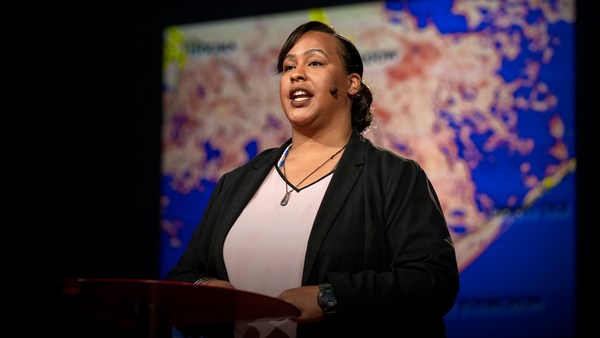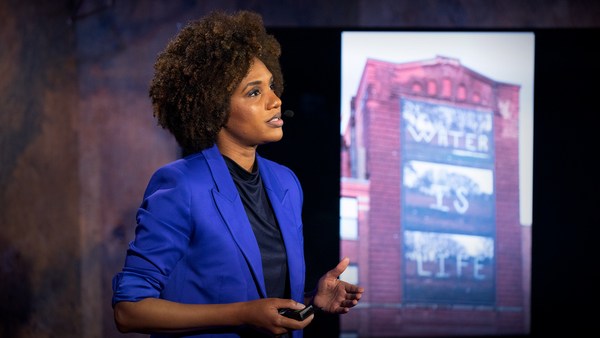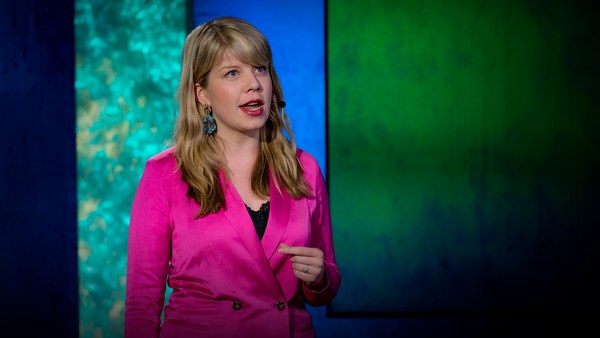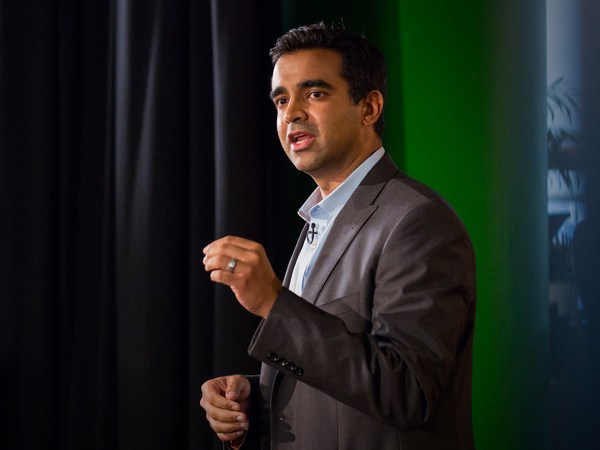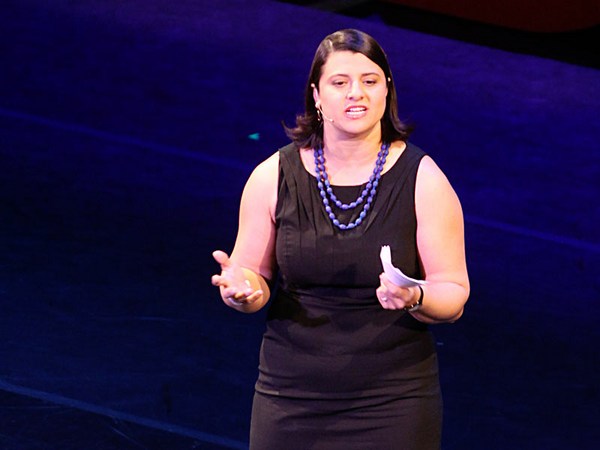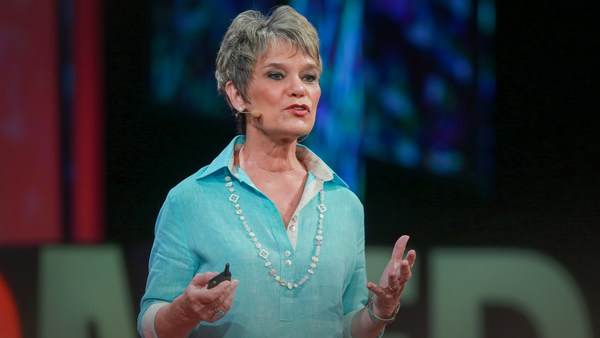I arrived in the US from Kingston, Jamaica in the summer of '68. My family of six crammed into a small, two-bedroom apartment in a three-story walk-up in Brooklyn. The block had several children -- some spoke Spanish, some spoke English. Initially, I wasn't allowed to play with them because, as my parents said, "Them too rambunctious" --
(Laughter)
so I could only watch them from my window. Rollerskating was one of their favorite activities. They loved hitching a ride at the back of the city bus, letting go of the rear bumper as the bus arrived at the bottom of the block in front of my building. One day there was a new girl with them. I heard the usual squeals of laughter interspersed with, "Mira, mira! Mira, mira!" Spanish for, "Look, look!" The group grabbed onto the back of the bus at the top of the block, and as they rolled down laughing and screaming, "Mira, mira, mira, mira," the bus abruptly stopped. The experienced riders adjusted and quickly let go, but the new girl lurched back and fell onto the pavement. She didn't move.
The adults outside ran to help her. The bus driver came out to see what had happened and call for an ambulance. There was blood coming from her head. She didn't open her eyes. We waited for the ambulance, and waited, and everyone said, "Where is the ambulance? Where is the ambulance?" The police finally arrived. An older black American man said, "Ain't no ambulance coming." He said it again loudly to the cop. "You know ain't no ambulance coming. They never send no ambulance here." The cop looked at my neighbors who were getting frustrated, lifted the girl into the patrol car and left.
I was 10 years old at the time. I knew this wasn't right. I knew there was something more we could do. The something I could do was become a doctor. I became an internist and committed my career to caring for those we often call the underserved, the vulnerable, like those neighbors I had when I first immigrated to America.
During my early training years in Harlem in the '80s, I saw a shocking increase in young men with HIV. Then when I moved [to] Miami, I noticed HIV included women and children, primarily, poor black and brown people. Within a few years, an infection seen in a select population became a worldwide epidemic. Again I got the urge to do something. Fortunately, with the help of activists and advocates and educators and physicians like me who treat the disease, we found a way forward. There was a massive education effort to reduce HIV transmission and provide legal protection for those with the disease. There was a political will to make sure that as many patients as possible worldwide, regardless of ability to pay, could get access to medication. Within a couple of decades there were new treatments that transformed this life-threatening infection to a chronic disease, like diabetes. Now there's a vaccine on the horizon.
Over the last five to seven years, I've noticed a different epidemic among the patients in Florida, and it looks something like this. Ms. Anna Mae, a retired clerical worker living on a fixed income in Opa-locka, walked in for medication refills. She had common chronic conditions of high blood pressure, diabetes, heart disease and asthma with overlapping chronic obstructive pulmonary disease -- COPD. Ms. Anna Mae was one of my more adherent patients, so I was surprised she needed refills of her breathing medicines earlier than usual. Towards the end of the visit, she handed me a Florida Power and Light form and asked me to sign it. She was behind on her light bill. This form allowed physicians to document serious medical conditions requiring equipment that would be impacted if the patient's electricity was disconnected. "But Ms. Anna Mae," I said, "you don't use any medical devices for breathing. I don't think you qualify." Further questioning revealed she had been using her air conditioner day and night because of the heat so she could breathe. Needing to buy more asthma inhalers left her little money; she couldn't pay all the bills so it piled up. I filled out the form, but knowing she might be denied, I also sent her to the social worker.
Then there was Jorge, such a sweet, kind man who often gifted our clinic with some of the fruits he sold on the streets of Miami. He had signs of worsening kidney function whenever he worked days on end on those hot streets due to dehydration -- just not enough blood getting to the kidneys. His kidneys worked much better whenever he took some days off. But with no other support, what could he do? As he says, "Rain or shine, cold or heat, I have to work."
But the most damning case of all may be Ms. Sandra Faye Twiggs of Fort Lauderdale with COPD. She was arrested after fighting with her daughter over a fan. On her release from jail, she returned to her apartment, coughed nonstop and died three days later.
Here's what else I noticed: the data show allergy seasons are starting weeks earlier, nighttime temperatures are rising, trees are growing faster and mosquitos carrying dangerous diseases like Zika and dengue are showing up in areas they didn't exist before.
I also see signs of impending climate gentrification. That's when richer people move into poorer neighborhoods that are at higher elevation and less subject to flood damage from climate change. Like in my patient Madame Marie who came in stressed and anxious, because she was evicted from her apartment in Miami's Little Haiti to make room for a luxury apartment complex whose developers understood that Little Haiti would not flood because it's ten feet above sea level.
An undeniable, clear and consistent warming trend is on the way. A health emergency even bigger than HIV/AIDS seems to be in the works, and it was my low-income patients that were dropping clues of what this would look like. This new epidemic is climate change, and it has a variety of health effects. Climate change impacts us in four major ways. Directly, through heat, extreme weather and pollution; through the spread of the disease; through disruption of our food and water supply; and through disruption of our emotional well-being. In medicine we use mnemonics to aid our memory, and this mnemonic, "heatwave," shows the eight significant health effects of climate change.
H: Heat illnesses.
E: Exacerbation of heart and lung disease.
A: Asthma worsening.
T: Traumatic injuries, especially during extreme weather events.
W: Water and foodborne illnesses.
A: Allergies worsening.
V: Vector-borne diseases spreading, like Zika, dengue and Lyme.
And E: Emotional stresses increasing.
Poor, vulnerable people are already feeling the effects of climate change. They are the proverbial canary in a coal mine. Truly, their experiences are like oracles or prophecies. The guiding light for us to pay attention that we are doing something to our world first that's hurting them first. But in a matter of time, we are next.
If we act together -- doctors, patients and other health professionals -- we will find solutions. We have done this with the HIV crisis. There [it] was thanks to the activism of patients with HIV that demanded medications and better research, and the collaboration of doctors and scientists that we were able to control the epidemic. And then it was thanks to international health agencies, NGOs, politicians and pharmaceutical companies that HIV medication became available in low-income countries. There is no reason we can't also apply this model of collaboration to address the health effects of climate change before it's too late.
Climate change is here. It's already damaging the health and homes of poor people. Like my patient Jorge, most of us will have to work, whether rain or shine, cold or heat. But together these patients and their doctors, hand-in-hand, with some basic tools, can do so much to make this climate transition less brutal for all of us.
These patients inspired me to found a clinicians' organization to fight climate change. We focus on understanding the health effects of climate change, learning to advocate for patients with climate-related illnesses and encouraging real-world solutions.
A recent Gallup study showed three of the most respected professions are nurses, doctors and pharmacists. So as respected members of society, we have amplified voices to influence climate change policy and politics. There is so much we can do. As clinicians, our many patient contacts allows us to see things before others. And this puts us in an ideal position to be on the frontlines of change.
We can teach climate-related illnesses in our health-professional schools. We can collect data on our patients' climate-related conditions by making sure there are billing codes to identify them. We can do climate-related health research. We can teach how to have green practices in homes. We can advocate for our patient energy needs. We can help them get safer homes. We can help them get necessary equipment in those homes when conditions worsen. We can testify in front of lawmakers as to the findings, and we can medically treat our patients' climate-related illnesses. Most importantly, we can help prepare our patients mentally and physically for the health challenges they will face, using a model of medicine that incorporates economic and social justice.
This would mean Ms. Sandra Faye Twiggs with COPD, who died after being released from jail after a fight with her daughter over a fan, would have known that the heat in her apartment made her sick and angry and seek a safer place to go for cooling. Even better, her apartment would never have been so hot.
From the poor, I've learned our lives are not only vulnerable but are stories of resilience, innovation and survival. Like that wise old man who loudly spoke truth to the cop that summer night: "Ain't no ambulance coming," and compelled him to deliver that little girl to the hospital instead.
You know what? Listen up. If there's going to be a medical response to climate change, it is not going to be just waiting for an ambulance. It is going to happen because we the clinicians take the first step. We make so much noise that the issue cannot be ignored or misunderstood. It is going to start with the stories our patients tell and the stories we tell on their behalf. We're going to do what is right for our patients like we've always done, but also what is right for our environment, for ourselves and for all the people on this planet -- all of them.
Thank you.
(Applause and cheers)
